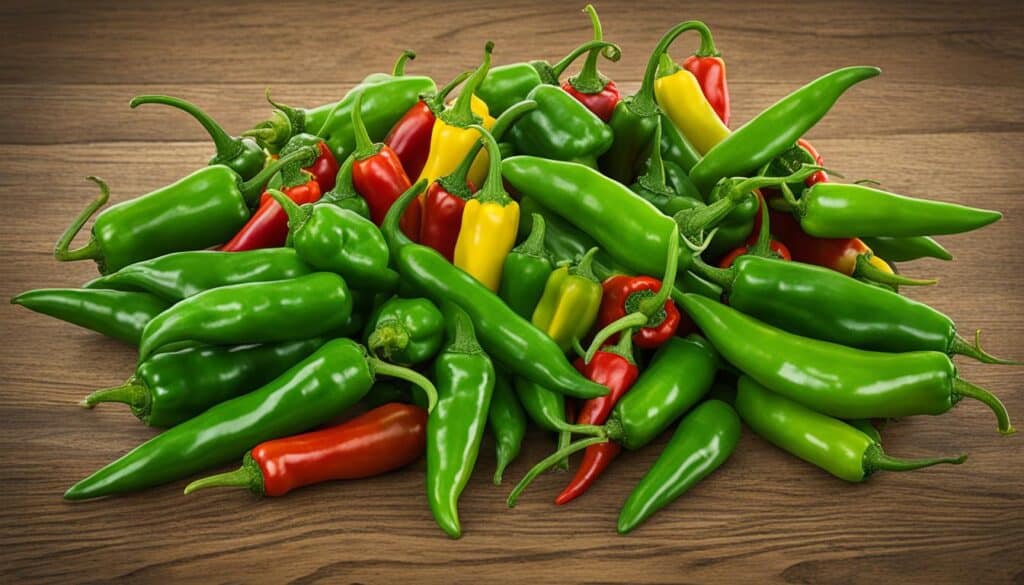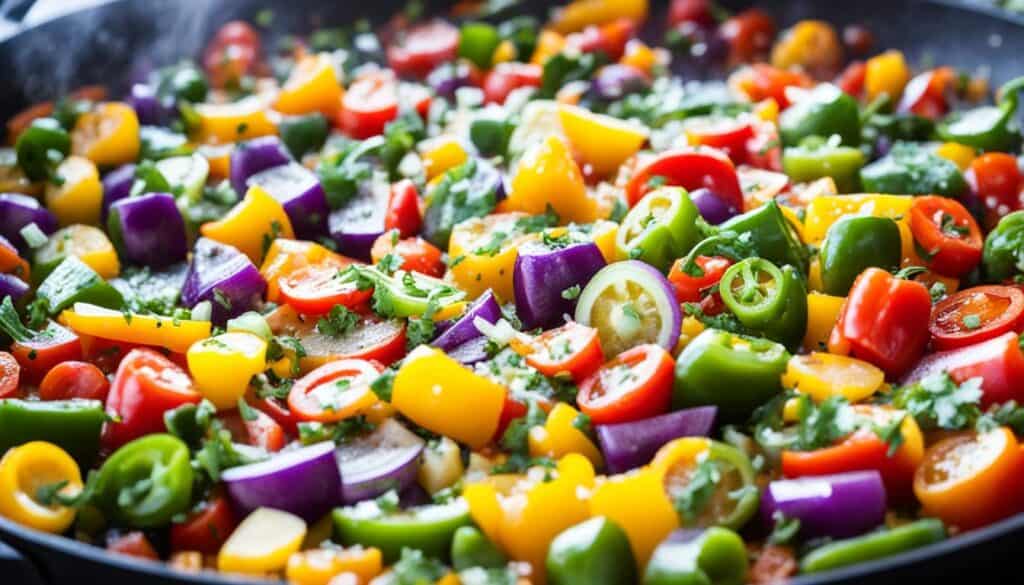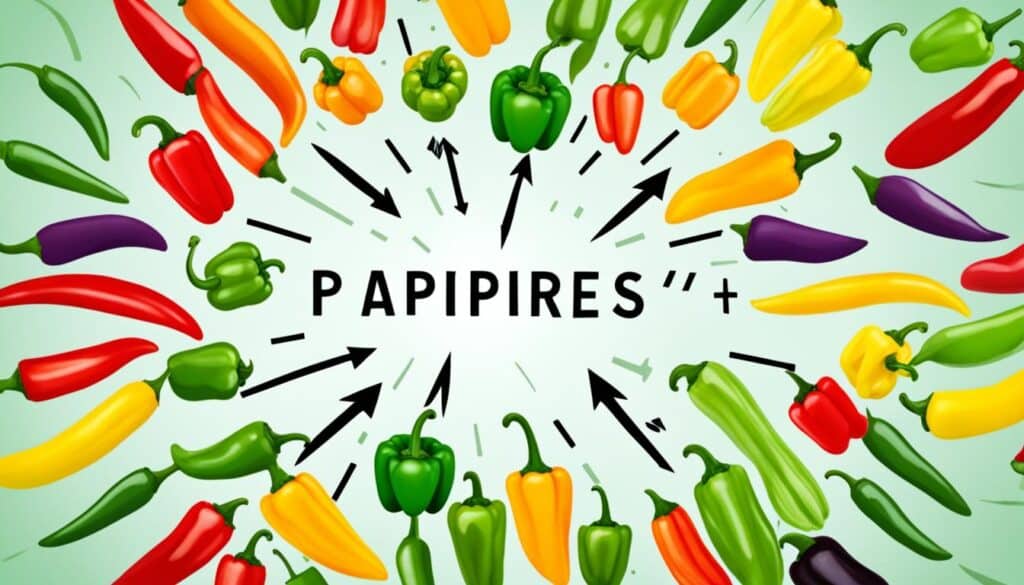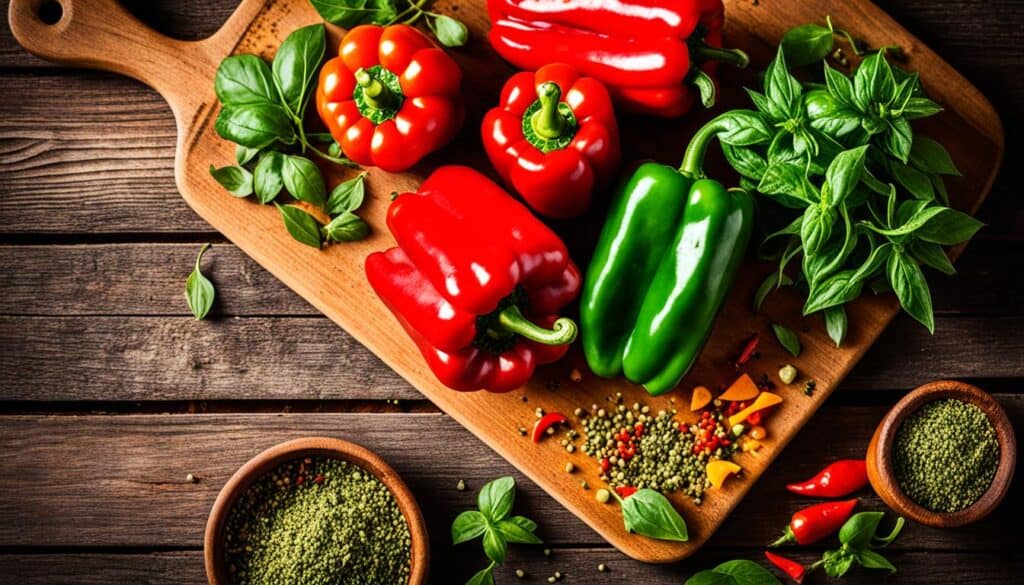Did you know that gypsy peppers have an interesting origin and unique appearance? These versatile peppers, believed to have originated in the Bay Area, come in various colors like lime green, red, and chocolate brown. With their thin skin and juicy texture, gypsy peppers are a culinary delight.
Key Takeaways:
- Discover delicious gypsy pepper recipes and cooking tips.
- Learn about substitutes for gypsy peppers and their nutritional benefits.
- Get insights on growing gypsy peppers at home.
Bacon-Wrapped Gypsy Pepper Stuffed with Fontina Cheese Recipe
One mouth-watering recipe featuring gypsy peppers is the Bacon-Wrapped Gypsy Pepper Stuffed with Fontina Cheese. This recipe calls for Gypsy peppers, Fontina cheese, and thinly sliced bacon. The peppers are slit and stuffed with cheese before being wrapped in bacon. They are then cooked until the bacon is seared and the cheese is melted. The result is a delicious appetizer or side dish bursting with flavor.
- Gypsy peppers
- Fontina cheese
- Thinly sliced bacon
To prepare the Bacon-Wrapped Gypsy Pepper Stuffed with Fontina Cheese, follow these simple steps:
- Preheat the oven to 375°F (190°C).
- Slit the Gypsy peppers lengthwise, and remove the seeds and membranes.
- Stuff the peppers with slices of Fontina cheese.
- Wrap each stuffed pepper with a slice of bacon, securing it with toothpicks if necessary.
- Place the bacon-wrapped peppers on a baking sheet.
- Bake for approximately 20 minutes or until the bacon is crispy and the cheese is melted.
- Remove from the oven and let cool for a few minutes before serving.
This delightful appetizer is perfect for parties, game nights, or simply as a tasty snack. The combination of the smoky bacon, creamy Fontina cheese, and mild heat of the Gypsy peppers creates an irresistible flavor profile. Serve these bacon-wrapped delights alongside a tangy dipping sauce for a delectable treat that will impress your guests.
Stuffed Gypsy Peppers with Fromage Blanc Filling
Another fantastic recipe using gypsy peppers is the Stuffed Gypsy Peppers with Fromage Blanc Filling. This recipe originated from Greens Restaurant in San Francisco. The peppers are roasted, peeled, and then filled with a mixture of Fromage blanc (or ricotta or fresh goat cheese), egg, and minced herbs. They are then baked until the peppers are puffed and the filling is set. The combination of the sweet peppers and creamy filling creates a delightful dish.
If you’re looking for a delicious and flavorful way to enjoy gypsy peppers, this stuffed pepper recipe is a must-try. The gypsy peppers bring a mild sweetness to the dish, while the creamy fromage blanc filling adds a rich and savory element. The roasted peppers have a tender texture that perfectly complements the smooth filling, creating a wonderful balance of flavors and textures.
To make these stuffed gypsy peppers, start by roasting the peppers until they are tender and the skin can easily be peeled off. While the peppers are roasting, prepare the filling by combining fromage blanc (or your preferred cheese), an egg, and minced herbs like parsley, thyme, or basil. Mix everything together until well combined.
Once the peppers are roasted and peeled, carefully cut a slit in each pepper and remove the seeds. Spoon the filling mixture into each pepper, making sure to distribute it evenly.
Place the stuffed peppers on a baking sheet and bake in a preheated oven at 375°F (190°C) for about 20-25 minutes, or until the peppers are puffed and the filling is set. The exact cooking time may vary depending on the size and thickness of the peppers.
Once the stuffed gypsy peppers are cooked, remove them from the oven and let them cool slightly before serving. These peppers can be enjoyed as a main course with a side of salad or as an appetizer for a dinner party or gathering.
This Stuffed Gypsy Peppers with Fromage Blanc Filling recipe is a great way to showcase the unique flavor of gypsy peppers while adding a creamy and savory twist. It’s a versatile dish that can be served on its own or as part of a larger meal. Give it a try and impress your friends and family with this delicious and visually appealing recipe.
Gypsy Pepper Origin and Appearance
Gypsy peppers have an interesting origin and unique appearance. They are believed to have originated in the Bay Area and were first encountered by a chef named Troy MacLarty at the St Helena Farmers Market in Napa Valley. These peppers are about four inches long, tapered, and come in various colors like lime green, red, and chocolate brown. Their appearance changes as they ripen, and they have a thin skin and juicy texture.
Gypsy peppers are not only flavorful but also visually appealing. Their vibrant colors make them a stunning addition to any dish. Whether they are used raw in salads or cooked in recipes, their appearance adds a touch of elegance to the plate.
Cooking with Gypsy Peppers
Gypsy peppers are incredibly versatile and can be enjoyed in various ways. Their mild and sweet flavor adds a unique touch to any dish. Here are some exciting ways to incorporate gypsy peppers into your cooking:
1. Raw Delights
Add thinly sliced gypsy peppers to your favorite salad for a refreshing crunch and vibrant color. Their subtle heat and crisp texture complement a variety of vegetables and dressings. You can also use them as a topping for sandwiches and wraps to add a burst of flavor.
2. Pizza Perfect
Slice gypsy peppers into thin rings and scatter them on your homemade or store-bought pizza. Their bright colors will not only make the pizza visually appealing but also enhance the taste. The peppers will become slightly charred and tender during baking, creating a delicious and colorful topping.
3. Stuffed Sensations
Take advantage of the gypsy peppers’ unique shape and stuff them with flavorful fillings. Whether it’s a mixture of creamy cheese, savory meats, or a combination of vegetables, the possibilities are endless. One popular option is to stuff gypsy peppers with a mixture of cream cheese, garlic, and herbs, then bake them until tender.
The combination of the gypsy pepper’s sweetness, smoky flavors, and creamy textures make it the perfect vessel for delicious fillings.
4. Peperonata Paradise
Make a classic Italian peperonata using gypsy peppers along with onions, tomatoes, and capers. This caramelized mixture offers a burst of flavors and can be used as a topping for grilled meats, a side dish for roasted chicken, or a flavorful sauce for pasta. It’s a versatile and hearty dish that showcases the natural sweetness of gypsy peppers.
| Benefits of Cooking with Gypsy Peppers |
|---|
| Enhances the flavor profile of dishes |
| Adds vibrant colors to your meals |
| Offers versatility in both raw and cooked preparations |
| Provides a mild heat that appeals to various taste preferences |
Now that you have some ideas for cooking with gypsy peppers, it’s time to get creative in the kitchen. From refreshing salads to stuffed sensations and flavorful sauces, gypsy peppers are sure to elevate your culinary creations.
Continue reading to learn about the substitutes for gypsy peppers and the nutritional benefits they offer.
Substitutes for Gypsy Peppers
If you can’t find gypsy peppers at your local grocery store or farmer’s market, there are a few substitutes you can use. Frying peppers like bull’s horn peppers can be a good alternative, as they have a similar shape and texture. You can also use bell peppers, although they have a milder flavor. When substituting, keep in mind that the taste and texture may vary slightly, but the overall result will still be delicious.
Substitutes for Gypsy Peppers:
- Frying peppers
- Bell peppers
Nutritional Benefits of Gypsy Peppers
Gypsy peppers not only add flavor to your dishes but also offer nutritional benefits. They are low in calories and high in dietary fiber, making them a great addition to a healthy diet. Gypsy peppers are also a good source of vitamins A and C, as well as antioxidants. Including gypsy peppers in your meals can help boost your immune system and promote overall well-being.
Here’s a breakdown of the nutritional value of gypsy peppers:
| Nutrient | Amount per 100g |
|---|---|
| Calories | 27 |
| Carbohydrates | 6g |
| Fiber | 2g |
| Vitamin A | 2000 IU |
| Vitamin C | 60mg |
| Potassium | 300mg |
As you can see, gypsy peppers are low in calories and provide a good amount of fiber, vitamins, and minerals. The dietary fiber can aid in digestion and help regulate blood sugar levels. Vitamins A and C are essential for maintaining a healthy immune system and promoting cell function. Potassium is an important mineral that helps maintain proper heart and muscle function. Including gypsy peppers in your meals can contribute to a well-balanced and nutritious diet.
Growing Gypsy Peppers at Home
If you’re interested in growing your own gypsy peppers, it is possible to do so at home. Gypsy pepper plants can be cultivated in containers or directly in the ground. They prefer full sun and well-drained soil. Seeds or seedlings can be obtained from nurseries or online suppliers. With proper care and maintenance, you can enjoy a bountiful harvest of fresh gypsy peppers right from your own backyard.
Conclusion
Gypsy peppers are a versatile ingredient that can elevate your culinary creations. Whether you’re a seasoned chef or a home cook, incorporating gypsy peppers into your recipes can add a unique twist to any dish. From stuffed peppers to savory appetizers, these vibrant peppers offer endless possibilities for experimentation in the kitchen.
Whether you prefer to enjoy their mild flavor raw or cook them to bring out their sweetness, gypsy peppers can be used in a variety of ways. They are perfect for stuffing with various fillings like cheese or cream, adding a burst of flavor to each bite. You can also slice them and incorporate them into your favorite pizzas or toss them into fresh salads for an extra crunch.
What sets gypsy peppers apart is their ability to enhance the taste of your dishes while offering nutritional benefits. Low in calories and high in dietary fiber, gypsy peppers are a healthy addition to any meal. They are also packed with vitamins A and C, as well as antioxidants, boosting your immune system and promoting overall well-being.
So, why not embark on a delicious culinary journey with gypsy peppers? Try out some gypsy pepper recipes and explore the endless possibilities they offer. From their unique taste to their vibrant appearance, gypsy peppers are sure to bring a touch of excitement to your cooking. Get creative in the kitchen and let the flavors of these versatile peppers take center stage.









Leave a Reply